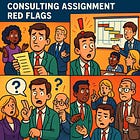What Every IT Consultant Should Know About Enterprise Architecture
It’s not just for architects—it’s a mindset for clarity, connection, and smarter decisions
I recently realized something surprising: for all the years I’ve written about consulting and IT careers in this publication, I’ve never actually written about one of my favorite topics—enterprise architecture (EA).
That’s ironic, considering I just published a book on it.
So, this felt like the right time to finally connect the dots. Not as a technical manual, but as a perspective on why every consultant should understand at least the basics of architecture thinking.
EA often sounds like something only big organizations or technical specialists care about. But in reality, it’s the invisible framework behind every meaningful IT initiative, and a mental model every consultant can benefit from.
EA thinking helps you:
Connect business goals with technology realities
Understand how one change affects the rest of the system
Communicate across silos
Avoid short-term fixes that create long-term problems
Even if you’ll never have “architect” in your title, understanding architecture principles makes you a more trusted advisor.
What is Enterprise Architecture?
At its core, EA is a structured way of understanding how an organization works—its people, processes, applications, and information—and how those parts fit together.
Architectural models and maps capture a huge amount of organizational knowledge. They show, for instance:
which business units own which processes,
what applications those processes depend on, and
how data flows across them.
In practice, EA supports the areas where organizations make development-related plans and decisions: strategy, portfolio management, and change initiatives.
In other words: architecture doesn’t replace management but strengthens it.
It makes decisions more transparent, aligns short-term actions with long-term goals, and helps leaders see the ripple effects of their choices.
Ultimately, EA is just a more systematic way to do what responsible leaders and consultants should already be doing—making informed, connected, and ethical decisions that serve the whole organization.
If you want a deeper dive into the basics of EA—starting from the nuances of the term itself—I’ve covered those foundations in my sister publication, Enterprise Architecture Transformation.
What Consultants Should Know About Enterprise Architecture
1. EA Is About Decisions, Not Diagrams
It’s easy to assume architecture is all about boxes and line. But the real purpose of EA is to enable better decisions: What should we change? What should stay? What can we afford to delay?
As a consultant, you’re constantly making or influencing those same decisions. EA gives you a structured way to think through the trade-offs.
2. Everything Connects to Something Else
Almost every IT consultant has seen projects fail because “nobody thought about the dependencies.”
Architecture thinking forces you to zoom out—to see how processes, data, systems, and people interconnect.
When you understand how your project fits into the larger landscape, you avoid surprises and design with intent, not accident.
3. Architecture Creates a Common Language
Ever been in a meeting where business talks strategy, IT talks applications, and nobody actually connects the dots?
That’s where architecture earns its keep. It provides shared concepts for alignment: capabilities, services, value streams, applications, data flows.
Even basic literacy in these ideas helps you facilitate better conversations—especially between non-technical and technical stakeholders.
4. Good EA Is About People as Much as IT
Architecture isn’t just about technology, it’s about how organizations work and change.
Who owns what? Who makes the decisions? What behaviors need to shift for the new structure to work?
Consultants who understand this human side of architecture can navigate resistance, design realistic roadmaps, and build trust faster.
5. You Don’t Need to Be an Architect to Think Like One
Architecture is less a role and more a way of thinking: structured, holistic, and pragmatic.
When consultants adopt that mindset, they bring clarity where others bring chaos. You don’t need a new title, just a broader lens.
Start small:
Ask how your project fits into the bigger picture. What does it enable, depend on, or constrain elsewhere?
Map dependencies before proposing solutions. Even a simple diagram on a whiteboard can save weeks of confusion later.
Draw what you mean. Don’t be afraid to visualize a process, application, or relationship. A quick sketch often communicates more clearly than a paragraph of text.
Trace the “why.” For every deliverable, link it back to the business goal it supports. That’s what makes architecture thinking valuable.
Think long-term impacts. What happens if this scales, changes ownership, or integrates with something new? Architecture is about sustainability as much as design.
That’s architecture in action—without ever opening a specialized software tool or learning a notation like ArchiMate.
Final Thoughts
EA isn’t just a discipline—it’s a lens for smarter consulting. It helps you connect business purpose with technical execution, and short-term delivery with long-term vision.
And once you start thinking like an architect, you’ll see your own consulting work differently: more connected, more deliberate, and ultimately, more impactful.
(If you’re curious to go deeper, I wrote about this in my book and in my sister publication, Enterprise Architecture Transformation).
See you next time,
Eetu Niemi
IT Consulting Career Hub 🚀
📚 Related Reads from the IT Consulting Career Hub
If this topic resonated with you, you might also enjoy:





